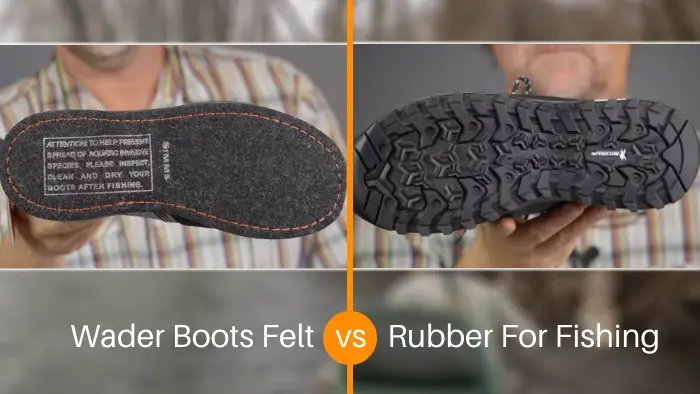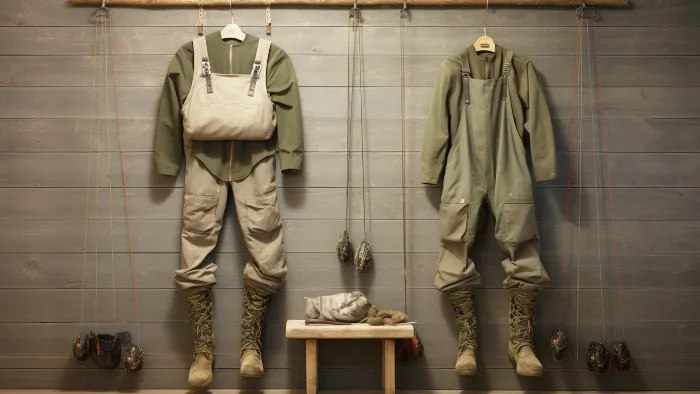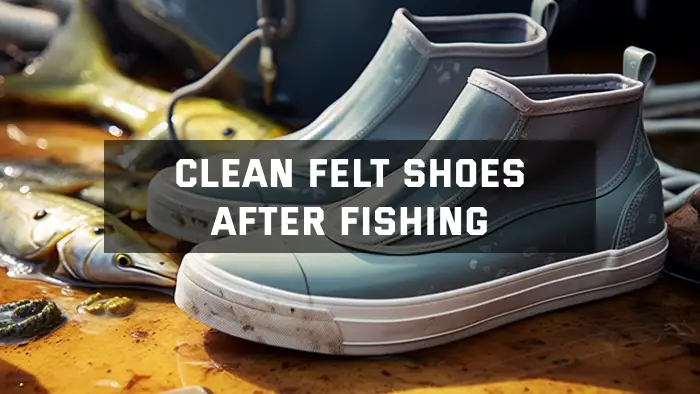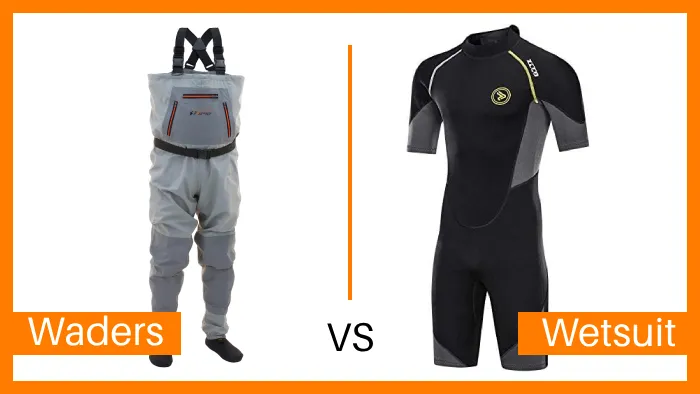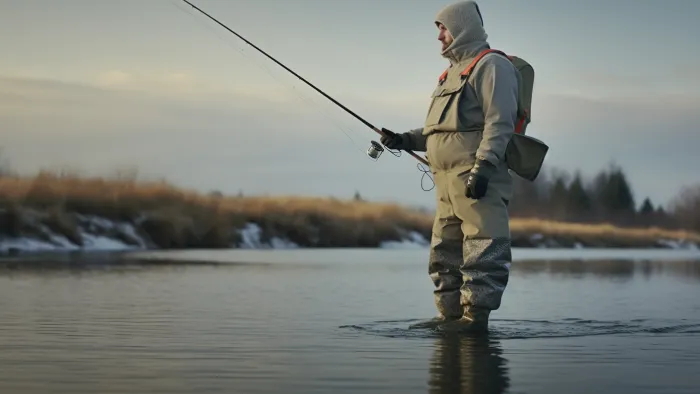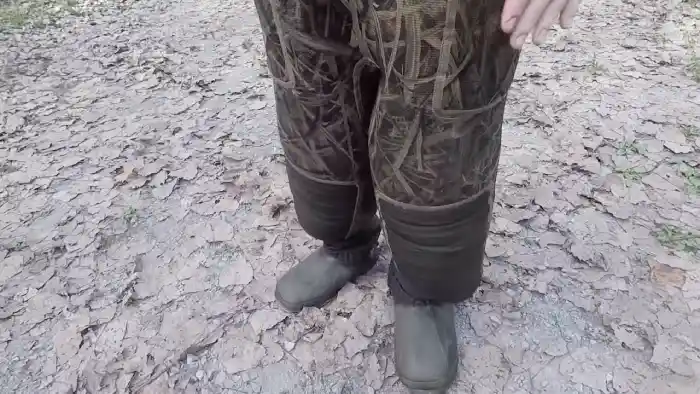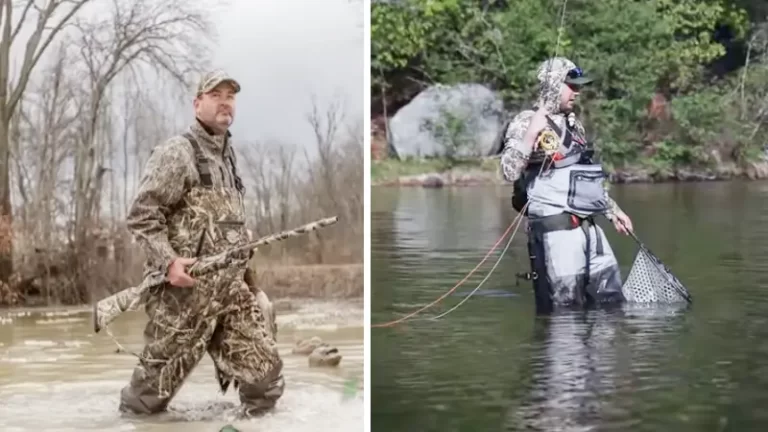Wader Boots Felt vs Rubber for Fishing: 9 Key Differences
As an angler, your choice of wader boots can make all the difference in your fishing experience. It’s like choosing between a trusty steed and a nimble gazelle. In the world of wader boots, there are two main contenders: Felt and Rubber.
Like a loyal companion, Felt provides superior traction on slippery rocks, keeping you steady and sure. Conversely, rubber is like a sturdy fortress, protecting your feet from sharp objects and providing durability that can withstand the test of time.
Also, felt excels in rivers and streams, where stability is key, while rubber shines in saltwater and muddy terrains, where protection is paramount.
The Differences Between Wader Boots Felt vs Rubber
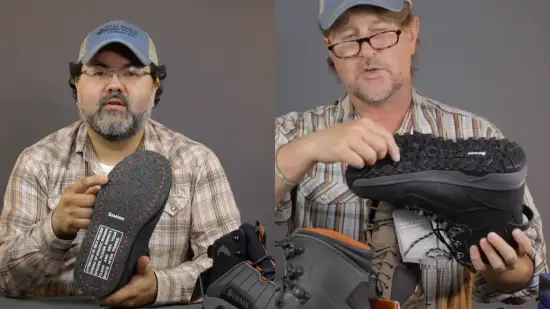
When choosing between wader boots with felt or rubber soles, there are several key factors to consider. But firstly, grip and traction on different surfaces can vary greatly between the two boots.
- Grip & traction on different surfaces
- Durability and longevity
- Resistance to punctures
- Comfort and support
- Weight and flexibility
- Waterproofing and insulation
- Performance in different temperatures
- Noise level while walking
- Cleaning and maintenance
- Cost and affordability
Grip & Traction on Different Surfaces
While rubber soles have come a long way and offer excellent grip on various surfaces, felt soles still stick to slippery rocks like glue. Felt soles have been the go-to choice for anglers for many years due to their exceptional traction on wet rocks in rivers and lakes.
The densely packed felt fibers create a large surface area that firmly grips the smoothest rocks, providing unparalleled stability and confidence while wading.
In contrast, rubber soles have evolved to provide a comparable level of grip on different terrains, including rocks, gravel, grass, and mud.
The improved design and advanced rubber compounds ensure that anglers can confidently navigate various surfaces without compromising durability.
Durability and Longevity
Despite their differences, anglers can rely on both types of soles’ durability and long-lasting performance to ensure their fishing adventures are worry-free.
Rubber soles are known for their exceptional durability, making them an excellent choice for anglers who frequently navigate rough and rocky terrains. These soles can withstand the wear and tear of constant use, providing reliable traction and stability.
Meanwhile, felt soles, although less durable than rubber, offer advantages. With proper care and maintenance, they can still provide long-lasting performance. Anglers should ensure that the felt soles are thoroughly cleaned and dried after each use to prevent damage and prolong their lifespan.
Resistance to Punctures
You’ll love how rubber soles with reinforced toe and heel caps offer superior resistance to sharp rocks and debris, ensuring your fishing adventures remain worry-free.
Unlike felt soles that sharp objects can easily puncture, rubber soles are designed to withstand the toughest conditions. The reinforced toe and heel caps provide an extra layer of protection, preventing any potential damage to the most vulnerable areas of the boots.
With rubber soles, you can confidently navigate through rocky terrains and brush off any puncture worries. For a better idea of the merits of rubber soles, let’s take a look at this comparison table:
| Feature | Rubber Soles | Felt Soles |
| Puncture Resistance | Excellent | Poor |
| Durability | High | Low |
| Protection | Reinforced toe and heel caps | None |
| Versatility | Suitable for various terrains | Limited to certain conditions |
Comfort and Support

Experience the ultimate comfort and support with rubber soles, which cradle your feet like a soothing embrace, ensuring you can fish all day without discomfort.
Rubber soles with good arch support are designed to provide maximum comfort, especially for anglers who spend long hours on their feet. The arch support helps to distribute your body weight evenly, reducing strain on your feet and preventing fatigue.
Also, the rubber material provides cushioning and shock absorption, allowing you to walk on various terrains without feeling the impact.
Although felt soles boots are designed to provide anglers with the ultimate comfort and ease of movement, these boots are more likely to develop uncomfortable pressure points or cause blisters of their lack of hardness.
Weight and Flexibility
Regarding long hikes and maneuverability, nothing beats the lightweight and flexible nature of felt sole wader boots. The weight of the boots is significantly reduced due to the absence of a heavier rubber sole, making them the go-to choice for those who prioritize agility and endurance.
Also, the flexibility of felt sole wader boots allows for a more natural stride, reducing fatigue and strain on the feet and legs. However, rubber sole wader boots offer more protection and support, which may be important for anglers who wade in challenging conditions.
To better understand the differences between felt sole and rubber sole wader boots, here’s a comparison:
| Felt Sole Wader Boots | Rubber Sole Wader Boots |
| Lightweight | Heavier |
| Flexible | Less flexible |
| Ideal for long hikes | Offers more support |
| Easy maneuverability | Enhanced protection |
Performance in Different Temperatures
With their ability to adapt to various climates, rubber-soled wader boots outshine their felt counterparts, ensuring optimal performance in any temperature. Rubber soles provide excellent traction and grip on slippery surfaces, making them reliable in cold and warm conditions.
When felt soles can freeze in winter, rubber soles remain pliable and effective, allowing you to traverse icy streams or snow-covered riverbanks confidently. In hot summer, rubber soles offer insulation against scorching ground temperatures, keeping your feet cool and comfortable.
The versatility of rubber soles means you can wear them year-round without compromising performance. Whether fishing in freezing temperatures or sweltering heat, rubber-soled wader boots will provide the support and stability you need to enjoy your fishing experience fully.
| Rubber-Sole Wader Boots | Felt-Sole Wader Boots | |
| Traction | Excellent on slippery surfaces | Less effective on slippery surfaces |
| Cold Weather Performance | Remains pliable and effective | Can freeze and become less effective |
| Hot Weather Performance | Offers insulation against scorching temperatures | Provides less insulation against hot ground temperatures |
| Versatility | Suitable for various temperatures and weather conditions | Limited suitability in extreme temperatures |
Noise Level While Walking
Not only do rubber-soled wader boots offer superior performance in various temperatures, but they also provide a stealthy and seamless wading experience due to their quieter nature.
When you’re out in the water, you want to blend in with your surroundings and not disturb the peace. Rubber soles on wader boots can be noisier and less subtle in calm areas, potentially scaring away fish and other wildlife.
On the other hand, felt sole wader boots offer a quieter and more natural wading experience. The soft and fibrous material absorbs the sound of your footsteps, allowing you to move silently through the water. This can be especially beneficial when fishing in calm and quiet areas, where noise can easily be detected.
Cleaning and Maintenance
When it comes to felt sole wader boots, be extra cautious due to the potential spread of invasive species. These boots require meticulous cleaning to remove debris or organisms clinging to them.
Regularly inspecting and scrubbing the felt soles is necessary to prevent the transfer of harmful organisms from one body of water to another.
In contrast, rubber sole wader boots offer a more convenient option. They are easier to clean and maintain, requiring less effort and time. A simple rinse and scrub will usually suffice to keep them in good condition.
Cost and Affordability
When considering the cost and affordability of different types of sole options for your fishing gear, weighing the long-term benefits and potential drawbacks is essential.
Felt sole wader boots may seem more economical, as they’re less expensive than rubber sole boots. However, remember that felt soles tend to wear out faster and may require more frequent replacement. This means that while saving money upfront, you may spend more in the long run.
Conversely, rubber sole wader boots may be more expensive initially, but they offer greater durability and versatility. They’re designed to withstand rough terrains and provide better traction, making them a worthy investment for avid anglers.
How to Clean and Disinfect Felt Sole Wading Boots?

You’ll need a detergent and a 5% salt solution to clean and disinfect your felt sole wading boots.
- Detergent
Detergent is an effective way to clean felt wader boots with a felt bottom. Follow these steps to clean your felt wader boots:
- When cleaning your boots, create a solution by mixing one cup of detergent or a specific boot-cleaning solution in a gallon of water.
- Once the solution is ready, soak your felt bottom boots for at least 30 minutes. This will allow the detergent to penetrate and remove any accumulated dirt or grime.
- After soaking, remove the boots and rinse them thoroughly with clean tap water. This step is crucial to ensure that all the detergent residue is removed.
- Finally, make sure to dry your boots completely before using them again. Following these steps, you can effectively clean and maintain your wader boots with a felt bottom, prolonging their lifespan and performance.
- 5% Salt
Salt is essential for disinfecting and maintaining wader boots with a felt bottom. When mixed with water, salt creates a saline solution that helps break down dirt, grime, and bacteria that can accumulate on your boots. The salt is a natural abrasive, gently scrubbing any stubborn stains or odors.
Soaking your boots in this saline solution for 30 minutes or more allows the salt to penetrate the felt fibers, ensuring a thorough cleaning. After soaking, rinse the boots with clean tap water to remove any remaining salt residue. The process removes dirt and bacteria and prevents mold and mildew growth.
Once rinsed, dry your boots entirely before storing them, as moisture can lead to unpleasant odors and damage the felt.
When should I put felt on wading boots for fishing?
When should you consider adding felt to your wading boots for fishing? The answer depends on the specific conditions in which you fish. Here are two situations where adding felt to your wading boots could be beneficial:
- Slippery riverbeds: Feeling soles can provide excellent traction if you often wade in rivers with sandy or gravelly bottoms. The felt material grips these surfaces, reducing the risk of slipping and falling.
- Rocky riverbeds: If you frequently fish in areas with rocky riverbeds, felt soles can help cushion your feet and provide additional comfort. The softness of the felt absorbs some of the impact from walking on uneven surfaces.
What are rubber fishing boots called?
Rainy days on the river bring to mind the comforting embrace of those sturdy, protective foot soldiers known as rubber fishing boots. These boots, also called waders, are designed to keep your feet dry and protected while navigating the slippery riverbeds.
Made from materials like vulcanized rubber, PVC, neoprene, or Gore-Tex, rubber fishing boots provide excellent waterproofing capabilities. They are popular among anglers due to their durability and ability to withstand rugged terrains.
To give you a better understanding of the benefits of rubber fishing boots, let’s take a look at a comparison table:
| Rubber Fishing Boots | Advantages |
| Vulcanized Rubber | Excellent waterproofing, long-lasting |
| PVC | Lightweight, easy to clean |
| Neoprene | Insulation, flexibility |
| Gore-Tex | Breathability, moisture-wicking |
Are rubber-wading boots good for fishing?
You’ll quickly discover the benefits of donning trusty rubber-wading boots on your fishing adventures. These boots are comfortable, and durable and offer excellent traction and stability on various surfaces.
Here are some reasons why rubber wading boots are good for fishing:
- Versatility: Rubber soles perform well in different conditions, making them suitable for fishing in various terrains, including rocky riverbeds, slippery banks, or muddy shores.
- Protection: The sturdy rubber provides an extra layer of protection against sharp objects, such as rocks, shells, or broken glass, minimizing the risk of injuries.
- Easy Maintenance: Rubber-wading boots are easy to clean, unlike felt-sole boots. Simply rinse off any dirt or debris, allowing you to spend more time on the water and less time on maintenance.
- Winter Performance: Rubber soles are ideal for winter fly fishing in snowy conditions. They offer better grip, preventing slips and falls on icy surfaces.
When should I wear rubber-wading boots for fishing?
One interesting statistic to create imagery in your mind is that rubber soles provide 40% more traction than other materials, ensuring stability while fishing in various terrains.
This makes rubber-wading boots a great choice for fishing in conditions where you might encounter slippery rocks, moss-covered surfaces, or muddy riverbanks. Rubber soles offer excellent grip on these surfaces, minimizing the possibility of slipping and falling.
Also, rubber wading boots are highly durable and can withstand harsh weather conditions, which makes them ideal for fishing in winter or rainy seasons. They’re also ideal for fishing in snowy areas, as the rubber soles perform much better in snow than felt soles.
What type of felt is used on wading boots?
When discussing felt wading boots, the type of felt used is important. The felt on wading boots is typically made of extra-dense polyester fibers, providing a thickness of 10 mm for added durability.
This felt type is designed to provide excellent grip on slippery surfaces, such as rocks and moss-covered riverbeds. The dense fibers create a textured surface for better traction, allowing you to navigate the water confidently.
Also, the felt is available in the largest size, allowing shoemakers to cut it to the desired size for a custom fit.
Can I replace the old felt on the wading boots?
With a little prep work and Aquaseal FD Repair Adhesive, you can replace the old felt on your wading boots and give them a new lease on life.
Felt soles are commonly used on wading boots due to their excellent traction on wet rocks and algae-covered surfaces. Over time, these soles can wear out and lose their effectiveness. Luckily, you can easily replace them. Start by removing the old felt and cleaning the sole thoroughly.
Apply Aquaseal FD Repair Adhesive to the sole and press the new felt firmly onto it. Allow it to dry completely. With renewed grip and confidence, your wading boots are ready for a fly fishing adventure.
How can I dry felt wading boots after fishing?

Once you’ve finished fishing, remove any excess water from your boots by gently squeezing them or patting them dry with a towel. Then, it’s time to let them air dry. To do this effectively, follow these steps:
- First, ensure the upper body of your boots has dried completely before proceeding with the drying process.
- Next, hang your boots upside down on a shoe hanger or lay them on their side to allow for proper ventilation.
- Avoid direct sunlight or heat sources, which can damage the felt material.
- Lastly, be patient and give your boots ample time to dry thoroughly before using them again.
Which states do not allow felt-wading boots?
Maryland (in 2011), Alaska (in 2012), Missouri (in 2012), Rhode Island (in 2012), Nebraska (in 2013), and South Dakota (in 2013) are among the states that have implemented bans for felt-soled wading boots. These bans were put in place due to the potential harm felt-soled boots can cause aquatic ecosystems.
Felt soles have been found to harbor and transport invasive species, such as aquatic plants and parasites, from one body of water to another. This can have devastating effects on native fish populations and the overall health of the ecosystem.
As a result, these states have taken proactive measures to protect their waterways by prohibiting felt-soled boots. Anglers in these states are encouraged to switch to rubber-soled wading boots, which aren’t only more environmentally friendly and provide better traction and durability.
Felt Wading Boots or Rubber: Choose Wisely for a Successful Fishing Experience
Choosing between felt and rubber wader boots ultimately depends on your preference and fishing needs.
Felt-soled boots provide excellent traction on slippery surfaces but require regular cleaning and disinfecting to prevent the spread of invasive species. Conversely, rubber wader boots are durable, easy to clean, and suitable for various fishing conditions.
Remember to check the regulations of the states you plan to fish in, as some have banned the use of felt-soled boots. So, weigh your options and make an informed decision for a successful fishing experience.

